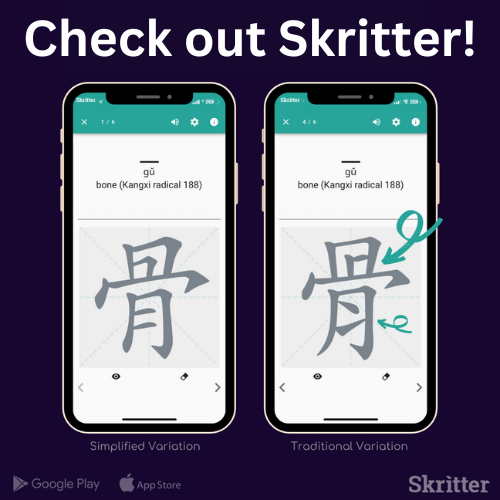🈶 The History of Chinese Characters — Simplified vs. Traditional
Posted on Feb 20, 2025 by Vocabulator Team

Chinese characters have a rich history that dates back thousands of years, evolving from ancient pictographs to the complex writing system we see today. One of the most prominent changes in the Chinese writing system is the development of simplified and traditional characters. Understanding the history and differences between these two systems is essential for anyone learning Mandarin or Cantonese.
In this post, we’ll explore the origins of Chinese characters, why simplification occurred, the key differences between simplified and traditional characters, and tips for learning both. 📝
📜 1. The Origins of Chinese Characters
The Chinese writing system is one of the oldest in the world, with roots tracing back over 3,000 years to the Shang Dynasty (~1600–1046 BCE). The earliest known form of Chinese characters is called 甲骨文 (jiǎgǔwén), or Oracle Bone Script, which was inscribed on animal bones and turtle shells for divination purposes.
Over time, Chinese characters evolved through several stages:
- 甲骨文 (Oracle Bone Script) — The earliest form, mainly pictographic.
- 金文 (Bronze Script) — Found on bronze vessels during the Zhou Dynasty, with more stylized characters.
- 篆书 (Seal Script) — Used during the Qin Dynasty (~221 BCE), leading to greater standardization.
- 隶书 (Clerical Script) — Simplified the complex strokes of Seal Script, making writing faster and easier.
- 楷书 (Regular Script) — The basis for modern Chinese characters, developed around the Han Dynasty.
Did You Know? Some modern characters still resemble their ancient pictographic origins. For example, the character for “sun” 日 was originally a simple circle with a dot in the center.
🔀 2. Why Were Chinese Characters Simplified?
During the 20th century, Chinese literacy rates were relatively low due to the complexity of traditional characters. In response, the Chinese government initiated a script reform to simplify the writing system, aiming to make it easier to learn and write.
📅 A Brief Timeline of Simplification:
- 1950s–1960s: The People's Republic of China introduced a standardized set of simplified characters (简体字, jiǎntǐzì) to improve literacy.
- 1977: A second wave of simplification was proposed but later retracted due to public backlash.
- Today: Simplified characters are officially used in mainland China, Singapore, and Malaysia, while traditional characters remain in use in Taiwan, Hong Kong, and Macau.
Reasons for Simplification:
- ✅ Ease of Learning: Fewer strokes make characters easier to write and memorize.
- ✅ Improved Literacy: Simplified characters were introduced to promote literacy in rural areas.
- ✅ Efficiency: Simplification speeds up handwriting and printing processes.
🆚 3. Simplified vs. Traditional — Key Differences
The main difference between simplified and traditional characters lies in the number of strokes and structural complexity. Simplified characters often reduce complex radicals and components, making them quicker to write but sometimes less visually descriptive.
🔤 Common Examples:
| Traditional (繁體字) | Simplified (简体字) | Pinyin | Meaning |
|---|---|---|---|
| 愛 | 爱 | ài | Love |
| 學 | 学 | xué | Study |
| 國 | 国 | guó | Country |
| 馬 | 马 | mǎ | Horse |
| 書 | 书 | shū | Book |
🔍 Simplification Methods:
- ✂️ Stroke Reduction: Complex strokes are removed (e.g., 學 → 学).
- 🔄 Radical Simplification: Simplified radicals replace complex ones (e.g., 龍 → 龙).
- 📑 Merging Characters: Some different traditional characters were merged into a single simplified character (e.g., 發 and 髮 both simplified to 发).
🌏 4. Where Are Simplified & Traditional Characters Used?
Knowing where each script is used can help learners decide which system to focus on:
- 📍 Simplified Chinese: Mainland China, Singapore, Malaysia
- 📍 Traditional Chinese: Taiwan, Hong Kong, Macau
- 📍 Overseas Chinese Communities: Both scripts are used depending on the region and community
Tip: If you plan to travel to Taiwan or Hong Kong, learning traditional characters is beneficial. For business or study in mainland China, simplified characters are the standard.
📖 5. Should You Learn Simplified or Traditional?
Choosing which script to study depends on your goals:
✅ Learn Simplified if you:
- Plan to live, work, or study in mainland China, Singapore, or Malaysia.
- Want an easier entry point into the language with fewer strokes.
- Prefer modern learning materials that mostly use simplified characters.
✅ Learn Traditional if you:
- Plan to visit or study in Taiwan, Hong Kong, or Macau.
- Have an interest in classical Chinese literature or calligraphy.
- Want a deeper cultural understanding through traditional scripts.
Pro Tip: Many learners start with simplified characters and later transition to traditional once they’re comfortable. Using tools like Vocabulator, you can switch between both scripts effortlessly while analyzing articles!
🛠 6. Best Tools to Learn Both Scripts
Whether you're learning simplified, traditional, or both, these resources can help you master Chinese characters effectively:
- 🔍 Vocabulator — Analyze Chinese articles in both simplified and traditional scripts, with pinyin, definitions, and grammar parsing.
- ✍️ Skritter — Master writing both scripts with guided stroke order and SRS (Spaced Repetition System).
- 📖 Pleco — A robust dictionary that supports both simplified and traditional characters.
- 🧠 Memrise — Flashcards and native speaker videos for vocabulary practice in both scripts.
Pro Tip: Use Vocabulator to analyze texts in simplified and then switch to traditional to see how characters differ. It's a great way to compare both scripts in context!
🎯 Final Thoughts
Both simplified and traditional Chinese characters hold significant cultural and historical value. Whether you choose to focus on one or master both, understanding their origins and differences will deepen your appreciation for the language.
With tools like Vocabulator and Skritter, learning Chinese characters — simplified or traditional — has never been easier. Dive into the world of Chinese scripts today and discover the beauty behind each character!
Happy studying! 加油!💪🈶
💬 Comments
Login to post a comment.






No comments yet. Be the first to comment!